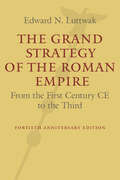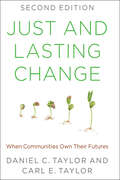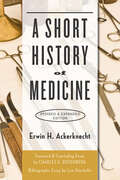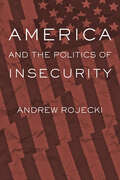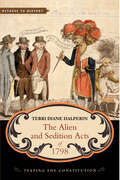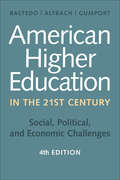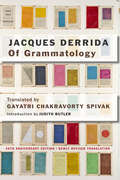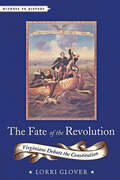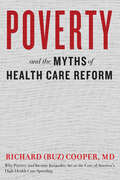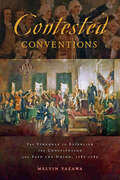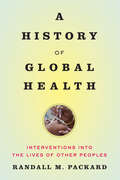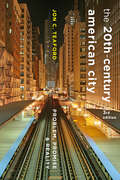- Table View
- List View
The Grand Strategy of the Roman Empire: From the First Century CE to the Third
by Edward N. LuttwakAt the height of its power, the Roman Empire encompassed the entire Mediterranean basin, extending much beyond it from Britain to Mesopotamia, from the Rhine to the Black Sea. Rome prospered for centuries while successfully resisting attack, fending off everything from overnight robbery raids to full-scale invasion attempts by entire nations on the move. How were troops able to defend the Empire;€™s vast territories from constant attacks? And how did they do so at such moderate cost that their treasury could pay for an immensity of highways, aqueducts, amphitheaters, city baths, and magnificent temples? In The Grand Strategy of the Roman Empire, seasoned defense analyst Edward N. Luttwak reveals how the Romans were able to combine military strength, diplomacy, and fortifications to effectively respond to changing threats. Rome;€™s secret was not ceaseless fighting, but comprehensive strategies that unified force, diplomacy, and an immense infrastructure of roads, forts, walls, and barriers. Initially relying on client states to buffer attacks, Rome moved to a permanent frontier defense around 117 CE. Finally, as barbarians began to penetrate the empire, Rome filed large armies in a strategy of "defense-in-depth," allowing invaders to pierce Rome;€™s borders. This updated edition has been extensively revised to incorporate recent scholarship and archeological findings. A new preface explores Roman imperial statecraft. This illuminating book remains essential to both ancient historians and students of modern strategy.
Just and Lasting Change: When Communities Own Their Futures
by Daniel C. Taylor Carl E. Taylor Mabelle and Raj Arole Abhay and Rani Bang, Zeng DongLu, Brenda M. Gourley, Shukria Hassan, Paz Magat, Patricia Paredes, Robert Parker, Besmillah Sakhizada, Jonathan M. Samet, Jac Smit, Henry G. Taylor, Luke C. Taylor-Ide, Miriam Were, and Heather Wipfli.How can public health workers, policy experts, and medical professionals work with members of developing nations to promote social change in rapid, cost-effective, and locally appropriate ways? In Just and Lasting Change, Daniel C. and Carl E. Taylor present readers with an innovative, proven, and site-specific guide to helping communities thrive through growing their own change in partnership with experts, donors, and government.The Taylors built their decades-long careers by partnering with key thinkers to combat inequity, environmental degradation, and globalization. The SEED-SCALE model they describe enables people (wherever they might live) to transform their communities by analyzing their local context in relation to the global, taking appropriate actions based on their priorities and resources, and assessing what succeeding actions may be needed to continue making progress.Just and Lasting Change describes, step by step, how the SEED-SCALE model can be effectively implemented. Drawing from a variety of engaging personal experiences and case studies, this wide-ranging book describes early attempts to promote social development a century ago, as well as current efforts in South America, Africa, and Asia. It also reveals how community-based social change unfolded in America, spurred at different points by Abraham Lincoln's leadership style and the Green Bay Packers's ownership model, and presents readers with thematic global examples from the anti-smoking campaign, Green Revolution, Child Survival Revolution, and urban agriculture. The second edition of this pathbreaking handbook offers a hopeful description of how people have improved the quality of life in diverse communities around the world and is fully revised and updated with Five completely new chapters Thirteen years of scholarship and global evidence Contributions from leading international experts in community-based development and public health
Just and Lasting Change: When Communities Own Their Futures
by Daniel C. Taylor Carl E. Taylor Mabelle and Raj Arole Abhay and Rani Bang, Zeng DongLu, Brenda M. Gourley, Shukria Hassan, Paz Magat, Patricia Paredes, Robert Parker, Besmillah Sakhizada, Jonathan M. Samet, Jac Smit, Henry G. Taylor, Luke C. Taylor-Ide, Miriam Were, and Heather Wipfli.How can public health workers, policy experts, and medical professionals work with members of developing nations to promote social change in rapid, cost-effective, and locally appropriate ways? In Just and Lasting Change, Daniel C. and Carl E. Taylor present readers with an innovative, proven, and site-specific guide to helping communities thrive through growing their own change in partnership with experts, donors, and government.The Taylors built their decades-long careers by partnering with key thinkers to combat inequity, environmental degradation, and globalization. The SEED-SCALE model they describe enables people (wherever they might live) to transform their communities by analyzing their local context in relation to the global, taking appropriate actions based on their priorities and resources, and assessing what succeeding actions may be needed to continue making progress.Just and Lasting Change describes, step by step, how the SEED-SCALE model can be effectively implemented. Drawing from a variety of engaging personal experiences and case studies, this wide-ranging book describes early attempts to promote social development a century ago, as well as current efforts in South America, Africa, and Asia. It also reveals how community-based social change unfolded in America, spurred at different points by Abraham Lincoln's leadership style and the Green Bay Packers's ownership model, and presents readers with thematic global examples from the anti-smoking campaign, Green Revolution, Child Survival Revolution, and urban agriculture. The second edition of this pathbreaking handbook offers a hopeful description of how people have improved the quality of life in diverse communities around the world and is fully revised and updated with Five completely new chapters Thirteen years of scholarship and global evidence Contributions from leading international experts in community-based development and public health
A Short History of Medicine
by Erwin H. Ackerknecht Lisa Haushofer.Erwin H. Ackerknecht;€™s A Short History of Medicine is a concise narrative, long appreciated by students in the history of medicine, medical students, historians, and medical professionals as well as all those seeking to understand the history of medicine.Covering the broad sweep of discoveries from parasitic worms to bacilli and x-rays, and highlighting physicians and scientists from Hippocrates and Galen to Pasteur, Koch, and Roentgen, Ackerknecht narrates Western and Eastern civilization;€™s work at identifying and curing disease. He follows these discoveries from the library to the bedside, hospital, and laboratory, illuminating how basic biological sciences interacted with clinical practice over time. But his story is more than one of laudable scientific and therapeutic achievement. Ackerknecht also points toward the social, ecological, economic, and political conditions that shape the incidence of disease. Improvements in health, Ackerknecht argues, depend on more than laboratory knowledge: they also require that we improve the lives of ordinary men and women by altering social conditions such as poverty and hunger.This revised and expanded edition includes a new foreword and concluding biographical essay by Charles E. Rosenberg, Ackerknecht;€™s former student and a distinguished historian of medicine. A new bibliographic essay by Lisa Haushofer explores recent scholarship in the history of medicine.
A Short History of Medicine
by Erwin H. Ackerknecht Lisa Haushofer.Erwin H. Ackerknecht;€™s A Short History of Medicine is a concise narrative, long appreciated by students in the history of medicine, medical students, historians, and medical professionals as well as all those seeking to understand the history of medicine.Covering the broad sweep of discoveries from parasitic worms to bacilli and x-rays, and highlighting physicians and scientists from Hippocrates and Galen to Pasteur, Koch, and Roentgen, Ackerknecht narrates Western and Eastern civilization;€™s work at identifying and curing disease. He follows these discoveries from the library to the bedside, hospital, and laboratory, illuminating how basic biological sciences interacted with clinical practice over time. But his story is more than one of laudable scientific and therapeutic achievement. Ackerknecht also points toward the social, ecological, economic, and political conditions that shape the incidence of disease. Improvements in health, Ackerknecht argues, depend on more than laboratory knowledge: they also require that we improve the lives of ordinary men and women by altering social conditions such as poverty and hunger.This revised and expanded edition includes a new foreword and concluding biographical essay by Charles E. Rosenberg, Ackerknecht;€™s former student and a distinguished historian of medicine. A new bibliographic essay by Lisa Haushofer explores recent scholarship in the history of medicine.
America and the Politics of Insecurity (Themes in Global Social Change)
by Andrew RojeckiIn America and the Politics of Insecurity, Andrew Rojecki assesses the response of citizens and politicians to a series of crises that confronted the United States during the first decade of the twenty-first century. This period brought Americans face to face with extraordinarily difficult problems that were compounded by their origin in seemingly uncontrollable global forces. Rojecki establishes a theoretical framework for understanding how these new uncertainties contribute to increasingly polarized political discourse. Analyzing three domains of American insecurity;¢;‚¬;€?economic, environmental, and existential;¢;‚¬;€?Rojecki examines responses to the Great Recession by groups like the Tea Party and Occupy Wall Street; considers why the growing demand for fossil fuels makes people disregard global warming; and explores the desire for security measures that restrict personal freedom in the age of terrorism. Ultimately, he explains why the right has thus far held an edge over the left in the politics of insecurity.Rojecki concludes that in order to address these broad-scale political problems, we must reframe domestic issues as reactions to undiagnosed global conditions. Bringing the psychology of uncertainty together with contemporary case studies, this book is a sweeping diagnostic for;¢;‚¬;€?and antidote to;¢;‚¬;€?ineffective political discourse in a globalized world that imports bads as well as goods.
America and the Politics of Insecurity (Themes in Global Social Change)
by Andrew RojeckiIn America and the Politics of Insecurity, Andrew Rojecki assesses the response of citizens and politicians to a series of crises that confronted the United States during the first decade of the twenty-first century. This period brought Americans face to face with extraordinarily difficult problems that were compounded by their origin in seemingly uncontrollable global forces. Rojecki establishes a theoretical framework for understanding how these new uncertainties contribute to increasingly polarized political discourse. Analyzing three domains of American insecurity;¢;‚¬;€?economic, environmental, and existential;¢;‚¬;€?Rojecki examines responses to the Great Recession by groups like the Tea Party and Occupy Wall Street; considers why the growing demand for fossil fuels makes people disregard global warming; and explores the desire for security measures that restrict personal freedom in the age of terrorism. Ultimately, he explains why the right has thus far held an edge over the left in the politics of insecurity.Rojecki concludes that in order to address these broad-scale political problems, we must reframe domestic issues as reactions to undiagnosed global conditions. Bringing the psychology of uncertainty together with contemporary case studies, this book is a sweeping diagnostic for;¢;‚¬;€?and antidote to;¢;‚¬;€?ineffective political discourse in a globalized world that imports bads as well as goods.
The Alien and Sedition Acts of 1798: Testing the Constitution (Witness to History)
by Terri Diane HalperinIn May 1798, after Congress released the XYZ Affair dispatches to the public, a raucous crowd took to the streets of Philadelphia. Some gathered to pledge their support for the government of President John Adams, others to express their disdain for his policies. Violence, both physical and political, threatened the safety of the city and the Union itself. To combat the chaos and protect the nation from both external and internal threats, the Federalists swiftly enacted the Alien and Sedition Acts. Oppressive pieces of legislation aimed at separating so-called genuine patriots from objects of suspicion, these acts sought to restrict political speech, whether spoken or written, soberly planned or drunkenly off-the-cuff. Little more than twenty years after Americans declared independence and less than ten since they ratified both a new constitution and a bill of rights, the acts gravely limited some of the very rights those bold documents had promised to protect.In The Alien and Sedition Acts of 1798, Terri Diane Halperin discusses the passage of these laws and the furor over them, as well as the difficulties of enforcement. She describes in vivid detail the heated debates and tempestuous altercations that erupted between partisan opponents: one man pulled a gun on a supporter of the act in a churchyard; congressmen were threatened with arrest for expressing their opinions; and printers were viciously beaten for distributing suspect material. She also introduces readers to the fraught political divisions of the late 1790s, explores the effect of immigration on the new republic, and reveals the dangers of partisan excess throughout history.Touching on the major sedition trials while expanding the discussion beyond the usual focus on freedom of speech and the press to include the treatment of immigrants, Halperin;€™s book provides a window through which readers can explore the meaning of freedom of speech, immigration, citizenship, the public sphere, the Constitution, and the Union.
The Alien and Sedition Acts of 1798: Testing the Constitution (Witness to History)
by Terri Diane HalperinIn May 1798, after Congress released the XYZ Affair dispatches to the public, a raucous crowd took to the streets of Philadelphia. Some gathered to pledge their support for the government of President John Adams, others to express their disdain for his policies. Violence, both physical and political, threatened the safety of the city and the Union itself. To combat the chaos and protect the nation from both external and internal threats, the Federalists swiftly enacted the Alien and Sedition Acts. Oppressive pieces of legislation aimed at separating so-called genuine patriots from objects of suspicion, these acts sought to restrict political speech, whether spoken or written, soberly planned or drunkenly off-the-cuff. Little more than twenty years after Americans declared independence and less than ten since they ratified both a new constitution and a bill of rights, the acts gravely limited some of the very rights those bold documents had promised to protect.In The Alien and Sedition Acts of 1798, Terri Diane Halperin discusses the passage of these laws and the furor over them, as well as the difficulties of enforcement. She describes in vivid detail the heated debates and tempestuous altercations that erupted between partisan opponents: one man pulled a gun on a supporter of the act in a churchyard; congressmen were threatened with arrest for expressing their opinions; and printers were viciously beaten for distributing suspect material. She also introduces readers to the fraught political divisions of the late 1790s, explores the effect of immigration on the new republic, and reveals the dangers of partisan excess throughout history.Touching on the major sedition trials while expanding the discussion beyond the usual focus on freedom of speech and the press to include the treatment of immigrants, Halperin;€™s book provides a window through which readers can explore the meaning of freedom of speech, immigration, citizenship, the public sphere, the Constitution, and the Union.
American Higher Education in the Twenty-First Century: Social, Political, and Economic Challenges
by Michael N. Bastedo Philip G. Altbach Patricia J. GumportFirst published in 1999, American Higher Education in the Twenty-First Century offered a comprehensive introduction to the central issues facing American colleges and universities. This thoroughly revised edition brings the classic volume up to date. The contributors have rewritten every chapter to address major changes in higher education, including the rise of organized social movements, the problem of income inequality and stratification, and the growth of for-profit and distance education. Three new chapters cover information technology, community colleges, and teaching and learning.This edition seeks to capture several crucial dynamics in the nexus of higher education and society. Placing higher education within its social and political contexts, the contributors discuss finance, federal and state governance, faculty, students, curriculum, and academic leadership. They also grapple with growing concerns about the future of the academy and reflect more deeply on the racial, ethnic, and socioeconomic diversity within higher education.No other book covers such wide-ranging issues under the broader theme of higher education;€™s relationship to society. Highly acclaimed and incorporating cutting-edge research, American Higher Education in the Twenty-First Century is now more useful and engaging than ever.Contributors: Michael N. Bastedo, Philip G. Altbach, Patricia J. Gumport, Benjamin Baez, Peter Riley Bahr, Joy Blanchard, Corbin M. Campbell, Melanie E. Corrigan, Peter D. Eckel, Roger L. Geiger, Lawrence E. Gladieux, Sara Goldrick-Rab, Jillian Leigh Gross, D. Bruce Johnstone, Adrianna Kezar, Jacqueline E. King, Aims C. McGuinness, Jr., Michael Mumper, Anna Neumann, Robert M. O;€™Neil, Laura W. Perna, Gary Rhoades, Roman Ruiz, Lauren Schudde, Sheila Slaughter, Daryl G. Smith
American Higher Education in the Twenty-First Century: Social, Political, and Economic Challenges
by Michael N. Bastedo Philip G. Altbach Patricia J. GumportFirst published in 1999, American Higher Education in the Twenty-First Century offered a comprehensive introduction to the central issues facing American colleges and universities. This thoroughly revised edition brings the classic volume up to date. The contributors have rewritten every chapter to address major changes in higher education, including the rise of organized social movements, the problem of income inequality and stratification, and the growth of for-profit and distance education. Three new chapters cover information technology, community colleges, and teaching and learning.This edition seeks to capture several crucial dynamics in the nexus of higher education and society. Placing higher education within its social and political contexts, the contributors discuss finance, federal and state governance, faculty, students, curriculum, and academic leadership. They also grapple with growing concerns about the future of the academy and reflect more deeply on the racial, ethnic, and socioeconomic diversity within higher education.No other book covers such wide-ranging issues under the broader theme of higher education;€™s relationship to society. Highly acclaimed and incorporating cutting-edge research, American Higher Education in the Twenty-First Century is now more useful and engaging than ever.Contributors: Michael N. Bastedo, Philip G. Altbach, Patricia J. Gumport, Benjamin Baez, Peter Riley Bahr, Joy Blanchard, Corbin M. Campbell, Melanie E. Corrigan, Peter D. Eckel, Roger L. Geiger, Lawrence E. Gladieux, Sara Goldrick-Rab, Jillian Leigh Gross, D. Bruce Johnstone, Adrianna Kezar, Jacqueline E. King, Aims C. McGuinness, Jr., Michael Mumper, Anna Neumann, Robert M. O;€™Neil, Laura W. Perna, Gary Rhoades, Roman Ruiz, Lauren Schudde, Sheila Slaughter, Daryl G. Smith
Of Grammatology
by Jacques DerridaJacques Derrida’s revolutionary approach to phenomenology, psychoanalysis, structuralism, linguistics, and indeed the entire European tradition of philosophyâ€�called deconstructionâ€�changed the face of criticism. It provoked a questioning of philosophy, literature, and the human sciences that these disciplines would have previously considered improper. Forty years after Of Grammatology first appeared in English, Derrida still ignites controversy, thanks in part to Gayatri Chakravorty Spivak’s careful translation, which attempted to capture the richness and complexity of the original. This fortieth anniversary edition, where a mature Spivak retranslates with greater awareness of Derrida’s legacy, also includes a new afterword by her which supplements her influential original preface. Judith Butler has added an introduction. All references in the work have been updated. One of contemporary criticism’s most indispensable works, Of Grammatology is made even more accessible and usable by this new release.
Of Grammatology
by Jacques DerridaJacques Derrida’s revolutionary approach to phenomenology, psychoanalysis, structuralism, linguistics, and indeed the entire European tradition of philosophyâ€�called deconstructionâ€�changed the face of criticism. It provoked a questioning of philosophy, literature, and the human sciences that these disciplines would have previously considered improper. Forty years after Of Grammatology first appeared in English, Derrida still ignites controversy, thanks in part to Gayatri Chakravorty Spivak’s careful translation, which attempted to capture the richness and complexity of the original. This fortieth anniversary edition, where a mature Spivak retranslates with greater awareness of Derrida’s legacy, also includes a new afterword by her which supplements her influential original preface. Judith Butler has added an introduction. All references in the work have been updated. One of contemporary criticism’s most indispensable works, Of Grammatology is made even more accessible and usable by this new release.
The Fate of the Revolution: Virginians Debate the Constitution (Witness to History)
by Lorri GloverIn May 1788, the roads into Richmond overflowed with horses and stagecoaches. From every county, specially elected representatives made their way to the capital city for the Virginia Ratification Convention. Together, these delegates;¢;‚¬;€?zealous advocates selected by Virginia;€™s deadlocked citizens;¢;‚¬;€?would decide to accept or reject the highly controversial United States Constitution, thus determining the fate of the American Republic. The rest of the country kept an anxious vigil, keenly aware that without the endorsement of Virginia;¢;‚¬;€?its largest and most populous state;¢;‚¬;€?the Constitution was doomed.In The Fate of the Revolution, Lorri Glover explains why Virginia;€™s wrangling over ratification led to such heated political debate. Beginning in 1787, when they first learned about the radical new government design, Virginians had argued about the proposed Constitution;€™s meaning and merits. The convention delegates, who numbered among the most respected and experienced patriots in Revolutionary America, were roughly split in their opinions. Patrick Henry, for example, the greatest orator of the age, opposed James Madison, the intellectual force behind the Constitution. The two sides were so evenly matched that in the last days of the convention, the savviest political observers still could not confidently predict the outcome.Mining an incredible wealth of sources, including letters, pamphlets, newspaper articles, and transcripts, Glover brings these remarkable political discussions to life. She raises the provocative, momentous constitutional questions that consumed Virginians, echoed across American history, and still resonate today. This engaging book harnesses the uncertainty and excitement of the Constitutional debates to show readers the clear departure the Constitution marked, the powerful reasons people had to view it warily, and the persuasive claims that Madison and his allies finally made with success.
The Fate of the Revolution: Virginians Debate the Constitution (Witness to History)
by Lorri GloverIn May 1788, the roads into Richmond overflowed with horses and stagecoaches. From every county, specially elected representatives made their way to the capital city for the Virginia Ratification Convention. Together, these delegates;¢;‚¬;€?zealous advocates selected by Virginia;€™s deadlocked citizens;¢;‚¬;€?would decide to accept or reject the highly controversial United States Constitution, thus determining the fate of the American Republic. The rest of the country kept an anxious vigil, keenly aware that without the endorsement of Virginia;¢;‚¬;€?its largest and most populous state;¢;‚¬;€?the Constitution was doomed.In The Fate of the Revolution, Lorri Glover explains why Virginia;€™s wrangling over ratification led to such heated political debate. Beginning in 1787, when they first learned about the radical new government design, Virginians had argued about the proposed Constitution;€™s meaning and merits. The convention delegates, who numbered among the most respected and experienced patriots in Revolutionary America, were roughly split in their opinions. Patrick Henry, for example, the greatest orator of the age, opposed James Madison, the intellectual force behind the Constitution. The two sides were so evenly matched that in the last days of the convention, the savviest political observers still could not confidently predict the outcome.Mining an incredible wealth of sources, including letters, pamphlets, newspaper articles, and transcripts, Glover brings these remarkable political discussions to life. She raises the provocative, momentous constitutional questions that consumed Virginians, echoed across American history, and still resonate today. This engaging book harnesses the uncertainty and excitement of the Constitutional debates to show readers the clear departure the Constitution marked, the powerful reasons people had to view it warily, and the persuasive claims that Madison and his allies finally made with success.
One Health and the Politics of Antimicrobial Resistance
by Laura H. KahnZoonoses;¢;‚¬;€?infectious diseases, such as SARS and mad cow, that originate in animals and spread to humans;¢;‚¬;€?reveal how intimately animal and human health are linked. Complicating this relationship further, when livestock are given antibiotics to increase growth, it can lead to resistant bacteria. Unfortunately, there are few formal channels for practitioners of human medicine and veterinary medicine to communicate about threats to public health. To address this problem, Dr. Laura H. Kahn and her colleagues are promoting the One Health concept, which seeks to increase communication and collaboration between professionals in human, animal, and environmental health.In One Health and the Politics of Antimicrobial Resistance, Dr. Kahn investigates the use of antibiotics and the surge in antimicrobial resistance in food animals and humans from a One Health perspective. Although the medical community has blamed the problem on agricultural practices, the agricultural community insists that antibiotic resistance is the result of indiscriminate use of antibiotics in human medicine. Dr. Kahn argues that this blame game has fueled the politics of antibiotic resistance and hindered the development of effective policies to address the worsening crisis.Combining painstaking research with unprecedented access to international data, the book analyzes the surprising outcomes of differing policy approaches to antibiotic resistance around the globe. By integrating the perspectives of both medicine and agriculture and exploring the history and science behind the widespread use of growth-promoting antibiotics, One Health and the Politics of Antimicrobial Resistance examines the controversy in a unique way while offering policy recommendations that all sides can accept.
One Health and the Politics of Antimicrobial Resistance
by Laura H. KahnZoonoses;¢;‚¬;€?infectious diseases, such as SARS and mad cow, that originate in animals and spread to humans;¢;‚¬;€?reveal how intimately animal and human health are linked. Complicating this relationship further, when livestock are given antibiotics to increase growth, it can lead to resistant bacteria. Unfortunately, there are few formal channels for practitioners of human medicine and veterinary medicine to communicate about threats to public health. To address this problem, Dr. Laura H. Kahn and her colleagues are promoting the One Health concept, which seeks to increase communication and collaboration between professionals in human, animal, and environmental health.In One Health and the Politics of Antimicrobial Resistance, Dr. Kahn investigates the use of antibiotics and the surge in antimicrobial resistance in food animals and humans from a One Health perspective. Although the medical community has blamed the problem on agricultural practices, the agricultural community insists that antibiotic resistance is the result of indiscriminate use of antibiotics in human medicine. Dr. Kahn argues that this blame game has fueled the politics of antibiotic resistance and hindered the development of effective policies to address the worsening crisis.Combining painstaking research with unprecedented access to international data, the book analyzes the surprising outcomes of differing policy approaches to antibiotic resistance around the globe. By integrating the perspectives of both medicine and agriculture and exploring the history and science behind the widespread use of growth-promoting antibiotics, One Health and the Politics of Antimicrobial Resistance examines the controversy in a unique way while offering policy recommendations that all sides can accept.
Poverty and the Myths of Health Care Reform
by Richard Buz CooperIn Poverty and the Myths of Health Care Reform, Dr. Richard (Buz) Cooper argues that US poverty and high health care spending are inextricably entwined. Our nation's health care system bears a financial burden that is greater than in any other developed country in large part because impoverished patients use more health care, driving up costs across the board.Drawing on decades of research, Dr. Cooper illuminates the geographic patterns of poverty, wealth, and health care utilization that exist across neighborhoods, regions, and states;¢;‚¬;€?and among countries. He chronicles the historical threads that have led to such differences, examines the approaches that have been taken to combat poverty throughout US history, and analyzes the impact that structural changes now envisioned for clinical practice are likely to have. His research reveals that ignoring the impact of low income on health care utilization while blaming rising costs on waste, inefficiency, and unnecessary care has led policy makers to reshape clinical practice in ways that impede providers who care for the poor.The first book to address the fundamental nexus that binds poverty and income inequality to soaring health care utilization and spending, Poverty and the Myths of Health Care Reform is a must-read for medical professionals, public health scholars, politicians, and anyone concerned with the heavy burden of inequality on the health of Americans.
Poverty and the Myths of Health Care Reform
by Richard Buz CooperIn Poverty and the Myths of Health Care Reform, Dr. Richard (Buz) Cooper argues that US poverty and high health care spending are inextricably entwined. Our nation's health care system bears a financial burden that is greater than in any other developed country in large part because impoverished patients use more health care, driving up costs across the board.Drawing on decades of research, Dr. Cooper illuminates the geographic patterns of poverty, wealth, and health care utilization that exist across neighborhoods, regions, and states;¢;‚¬;€?and among countries. He chronicles the historical threads that have led to such differences, examines the approaches that have been taken to combat poverty throughout US history, and analyzes the impact that structural changes now envisioned for clinical practice are likely to have. His research reveals that ignoring the impact of low income on health care utilization while blaming rising costs on waste, inefficiency, and unnecessary care has led policy makers to reshape clinical practice in ways that impede providers who care for the poor.The first book to address the fundamental nexus that binds poverty and income inequality to soaring health care utilization and spending, Poverty and the Myths of Health Care Reform is a must-read for medical professionals, public health scholars, politicians, and anyone concerned with the heavy burden of inequality on the health of Americans.
Contested Conventions: The Struggle to Establish the Constitution and Save the Union, 1787;€“1789
by Melvin YazawaThere is perhaps no more critical juncture in American history than the years in which Americans drafted the federal Constitution, fiercely debated its merits and failings, and adopted it, albeit with reservations. In Contested Conventions, senior historian Melvin Yazawa examines the political and ideological clashes that accompanied the transformation of the country from a loose confederation of states to a more perfect union.Treating the 1787;€“1789 period as a whole, the book highlights the contingent nature of the struggle to establish the Constitution and brings into focus the overriding concern of the framers and ratifiers, who struggled to counter what Alexander Hamilton identified as the "centrifugal" forces driving Americans toward a disastrous disunion. This concern inspired the delegates in Philadelphia to resolve through compromise the two most divisive confrontations of the Constitutional Convention;¢;‚¬;€?representation in the new Congress and slavery;¢;‚¬;€?and was instrumental in gaining ratification even in states where Antifederalist delegates comprised a substantial majority.Arguing that the debates over ratification reflected competing ideas about the meaning of American nationhood, Yazawa illuminates the nature of the crisis that necessitated the meeting at Philadelphia in the first place. Contested Conventions is a cohesive and compelling account of the defining issues that led to the establishment of the Constitution; it should appeal to history students and scholars alike.
Contested Conventions: The Struggle to Establish the Constitution and Save the Union, 1787;€“1789
by Melvin YazawaThere is perhaps no more critical juncture in American history than the years in which Americans drafted the federal Constitution, fiercely debated its merits and failings, and adopted it, albeit with reservations. In Contested Conventions, senior historian Melvin Yazawa examines the political and ideological clashes that accompanied the transformation of the country from a loose confederation of states to a more perfect union.Treating the 1787;€“1789 period as a whole, the book highlights the contingent nature of the struggle to establish the Constitution and brings into focus the overriding concern of the framers and ratifiers, who struggled to counter what Alexander Hamilton identified as the "centrifugal" forces driving Americans toward a disastrous disunion. This concern inspired the delegates in Philadelphia to resolve through compromise the two most divisive confrontations of the Constitutional Convention;¢;‚¬;€?representation in the new Congress and slavery;¢;‚¬;€?and was instrumental in gaining ratification even in states where Antifederalist delegates comprised a substantial majority.Arguing that the debates over ratification reflected competing ideas about the meaning of American nationhood, Yazawa illuminates the nature of the crisis that necessitated the meeting at Philadelphia in the first place. Contested Conventions is a cohesive and compelling account of the defining issues that led to the establishment of the Constitution; it should appeal to history students and scholars alike.
A History of Global Health: Interventions into the Lives of Other Peoples
by Randall M. PackardOver the past century, hundreds of billions of dollars have been invested in programs aimed at improving health on a global scale. Given the enormous scale and complexity of these lifesaving operations, why do millions of people in low-income countries continue to live without access to basic health services, sanitation, or clean water? And why are deadly diseases like Ebola able to spread so quickly among populations?In A History of Global Health, Randall M. Packard argues that global-health initiatives have saved millions of lives but have had limited impact on the overall health of people living in underdeveloped areas, where health-care workers are poorly paid, infrastructure and basic supplies such as disposable gloves, syringes, and bandages are lacking, and little effort has been made to address the underlying social and economic determinants of ill health. Global-health campaigns have relied on the application of biomedical technologies;¢;‚¬;€?vaccines, insecticide-treated nets, vitamin A capsules;¢;‚¬;€?to attack specific health problems but have failed to invest in building lasting infrastructure for managing the ongoing health problems of local populations.Designed to be read and taught, the book offers a critical historical view, providing historians, policy makers, researchers, program managers, and students with an essential new perspective on the formation and implementation of global-health policies and practices.
A History of Global Health: Interventions into the Lives of Other Peoples
by Randall M. PackardOver the past century, hundreds of billions of dollars have been invested in programs aimed at improving health on a global scale. Given the enormous scale and complexity of these lifesaving operations, why do millions of people in low-income countries continue to live without access to basic health services, sanitation, or clean water? And why are deadly diseases like Ebola able to spread so quickly among populations?In A History of Global Health, Randall M. Packard argues that global-health initiatives have saved millions of lives but have had limited impact on the overall health of people living in underdeveloped areas, where health-care workers are poorly paid, infrastructure and basic supplies such as disposable gloves, syringes, and bandages are lacking, and little effort has been made to address the underlying social and economic determinants of ill health. Global-health campaigns have relied on the application of biomedical technologies;¢;‚¬;€?vaccines, insecticide-treated nets, vitamin A capsules;¢;‚¬;€?to attack specific health problems but have failed to invest in building lasting infrastructure for managing the ongoing health problems of local populations.Designed to be read and taught, the book offers a critical historical view, providing historians, policy makers, researchers, program managers, and students with an essential new perspective on the formation and implementation of global-health policies and practices.
The Twentieth-Century American City: Problem, Promise, and Reality (The American Moment)
by Jon C. TeafordThroughout the twentieth century, the city was deemed a problematic space, one that Americans urgently needed to improve. Although cities from New York to Los Angeles served as grand monuments to wealth and enterprise, they also reflected the social and economic fragmentation of the nation. Race, ethnicity, and class splintered the metropolis both literally and figuratively, thwarting efforts to create a harmonious whole. The urban landscape revealed what was right;¢;‚¬;€?and wrong;¢;‚¬;€?with both the country and its citizens;€™ way of life. In this thoroughly revised edition of his highly acclaimed book, Jon C. Teaford updates the story of urban America by expanding his discussion to cover the end of the twentieth century and the first years of the next millennium. A new chapter on urban revival initiatives at the close of the century focuses on the fight over suburban sprawl as well as the mixed success of reimagining historic urban cores as hip new residential and cultural hubs. The book also explores the effects of the late-century immigration boom from Latin America and Asia, which has complicated the metropolitan ethnic portrait.Drawing on wide-ranging primary and secondary sources, Teaford describes the complex social, political, economic, and physical development of US urban areas over the course of the long twentieth century. Touching on aging central cities, technoburbs, and the ongoing conflict between inner-city poverty and urban boosterism, The Twentieth-Century American City offers a broad, accessible overview of America;€™s persistent struggle for a better city.
The Twentieth-Century American City: Problem, Promise, and Reality (The American Moment)
by Jon C. TeafordThroughout the twentieth century, the city was deemed a problematic space, one that Americans urgently needed to improve. Although cities from New York to Los Angeles served as grand monuments to wealth and enterprise, they also reflected the social and economic fragmentation of the nation. Race, ethnicity, and class splintered the metropolis both literally and figuratively, thwarting efforts to create a harmonious whole. The urban landscape revealed what was right;¢;‚¬;€?and wrong;¢;‚¬;€?with both the country and its citizens;€™ way of life. In this thoroughly revised edition of his highly acclaimed book, Jon C. Teaford updates the story of urban America by expanding his discussion to cover the end of the twentieth century and the first years of the next millennium. A new chapter on urban revival initiatives at the close of the century focuses on the fight over suburban sprawl as well as the mixed success of reimagining historic urban cores as hip new residential and cultural hubs. The book also explores the effects of the late-century immigration boom from Latin America and Asia, which has complicated the metropolitan ethnic portrait.Drawing on wide-ranging primary and secondary sources, Teaford describes the complex social, political, economic, and physical development of US urban areas over the course of the long twentieth century. Touching on aging central cities, technoburbs, and the ongoing conflict between inner-city poverty and urban boosterism, The Twentieth-Century American City offers a broad, accessible overview of America;€™s persistent struggle for a better city.
